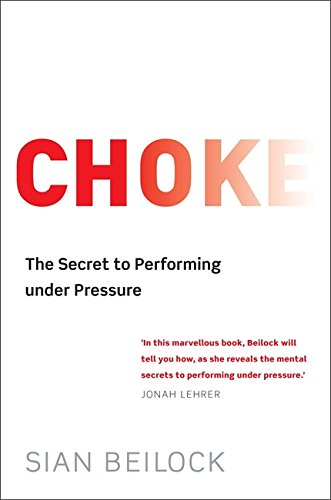Choking and Performance Anxiety
Choking is a form of performance anxiety where we want to perform at our best, but the pressure gets to us, and we just can’t pull it off in the moment.
Choking can be real problem for anyone who needs to perform well under pressure. For example, athletes, musicians, sales people, presenters, students doing exams etc.
Sian Beilock is a cognitive scientist by training and serves as the eighth President of Barnard College at Columbia University. She has published 2 critically acclaimed books, and over 100 peer-reviewed publications.

Sian studies how performance anxiety can be exacerbated or alleviated, and simple strategies that ensure success under pressure.
In her book, Choke, The Secret of Performing under Pressure, she details why choking occurs, and outlines many strategies to alleviate performance anxiety and choking under pressure.
Procedural v Working Memory
Our procedural memory is used to store our skills that we do really well, and are pretty much automatic. We don’t need to think too much about them, we just perform them on autopilot.
Our working memory is used for things like juggling numbers, planning for the future, or making decisions. It’s very limited, and that’s why it’s not a good idea to drive and talk on phone at the same time. It splits the working memory in two.
A good example of the limits to our working memory can be illustrated with a simple task. Firstly, read a list of digits, and repeat them back in order. Now, do the task again, but this time repeat the digits backwards.
Our working memory has to hold the digits, and then reverse the order, making it harder, slower, and more prone to mistakes.
Choking occurs when our working memory gets involved whilst performing, and becomes ultra aware of the performance. It’s a little like walking down the stairs, but paying a lot of attention to what our left knee is doing. It increases the changes we might fall.
Choking under pressure, isn’t due to a lack of experience, but often consequence of experience and caring too much.
One reason skilled professionals do better than the public is they don’t expend a lot of working memory as they have seen many of the situations before and know how to perform. They can focus the working part of their memory on the parts of the game that are truly novel.
For example, a concert pianist isn’t having to think about what their fingers are doing, so they can concentrate on interpreting the melody.
It’s really important to be able to focus, but we need to be able to focus on the right things.
Therefore, when we have learned something, and when we can do it on autopilot, it’s better not to focus on all the details. This prevents the working memory getting in the way.
Pressure and Underperformance
Researchers have shown, that when exam anxious students were under pressure they underperformed, were less creative, and less able to solve simple problems.
The researchers also showed that different areas of the brain were not communicating as well as they should.
Interestingly, in a study of students with anxiety about maths, even when they just knew a maths test was coming, areas of the brain lit up involved in our neural pain matrix.
So, the same parts of the brain that are involved when we stub our toe, or prick a finger are activated.
Learn to Thrive Under Pressure
In her book, Sian explains, that not all performers choke under pressure, and some actually thrive. She believes that these are skills that can be learned by anyone.
Below is a list of 10 Tips Sian recommends to NOT choke under pressure, and consequently, perform better.
10 Tips to NOT choke under pressure
1. Keep the working memory busy
In order to stop working memory kicking in and disrupting our performance, we can give it something else to do – to keep it busy.
Some examples are
- Counting backwards
- Singing a song
- Focusing on one key thought
- Focusing on a body part, like the little toe.
Sian like to sing the song “”Take it easy song” by the Eagles when performing.
2. Remind ourselves why we deserve to succeed
Reminding ourselves of why we deserve to succeed can lead to better performance.
E.g. “Even though everyone in that room is smarter than me, I know the material better than anyone else. I’m the master of this”.
3. Focus on the breath
Focusing on our breath can calm us down, but also give our working memory a task.
This in turns limits our working memory from getting in the way of our procedural memory.
4. Distract ourselves pre-performance
Shortly before an event is about to start, distract ourselves with something completely different.
Many athletes like to listen to music, do crossword puzzles, watch movies, or read magazines in the last minutes and hour before performance commences.
5. Set positive expectations
The Pygmalion effect demonstrates that when we expect to do well, we increase the likelihood that we perform well. Conversely, if we expect to perform badly, we are more likely to perfom badly.
Setting positive expectations that we will do well, and can always improve, can boost performance.
6. Minimise the impact of things going wrong
Airline cockpits are designed to assume pilots are going to make mistakes, and so they set out to minimise impact of those mistakes.
We can reduce pressure on ourselves if we set up systems to minimise the impact should things go wrong or we make mistakes.
For example, having backup equipment, leaving early, writing “to bring” lists, having a plan B, C, D etc.
Thinking through the things that might go wrong, and taking measures to minimise their risk or impact will increase confidence when things don’t go to plan.
Jotting down stresses or worries before a stressful event can also make them less likely to pop up in the moment.
8. Practice performing under pressure
The best way to learn to perform under pressure is to perform under pressure.
We can mimic pressure in practice, and by continual exposure to those triggers, we can reduce anxiety and perform better.
Exposure therapy can close the gap between training and competition.
So for example, if a child plays high level tennis, having the parents there during many practice sessions will improve the child’s ability to perform for real with their parents watching.
Somebody giving presentations, can practice talking infront of people before the official presentation.
9. Reframing physiological signals
The physiological signals for anxiety and excitment are the same. The difference is the story we tell ourselves.
So by labelling or reinterpreting sweaty palms, racing heart, palpitations, butterflies etc as signals of “excitment” or “thriving” or “our mind & body preparing to perform well” we can feel calmer and perform better.
10 – Practice Practice Practice
Nothing can replace practice. The more we practice, the more our procedural memory can do the tasks automatically. This allows our working memory to focus on more novel aspects of the performance .
There is an old warrior mantra “The more you sweat in training, the less you bleed in battle”.
Bonus Tip – Hypnotherapy for Peak Performance
Visualisation, Guided Meditation, and Hypnosis for Peak Performance are extremely beneficial to performers from recreational to professional.
It’s very common for many pro-athletes & professional performers to use guided imagery or hypnosis as part of their training.
These techniques are simple and can be done by anyone on their own, or with the help from a professional.
I’ve worked with professional fighters, athletes, muscians, authors, and actors over the years to help them perform at their best with unbeatable confidence.
Hypnotherapy cannot replace skill, but it can help us to perform at our best on the day.
If you are interested in seeing a professional for performance hypnotherapy feel free to contact me for more information,


